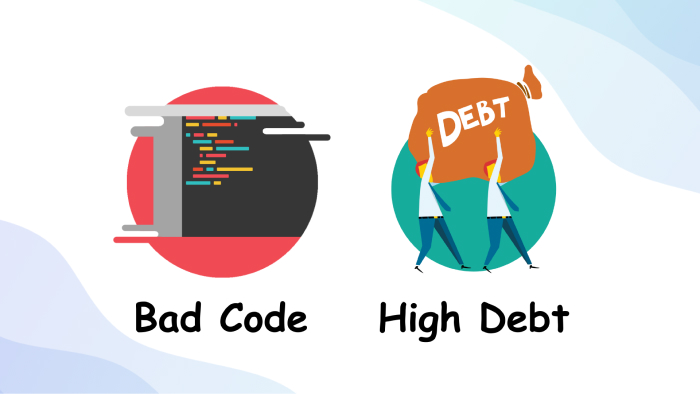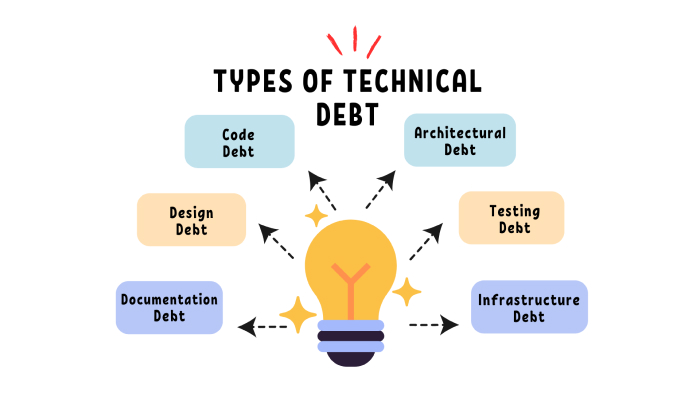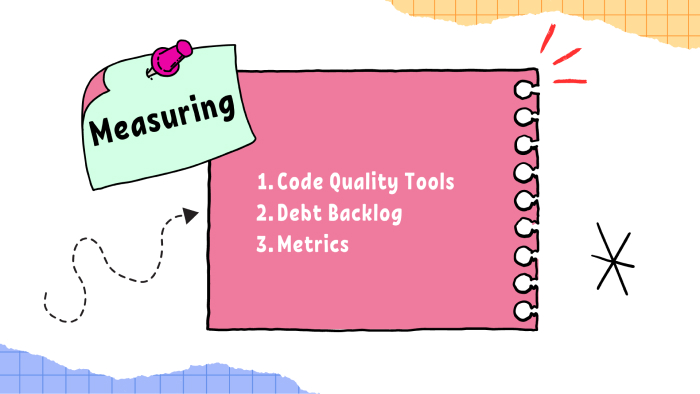
## Introduction
According to the Global CTO Survey 2023 report, the biggest challenge for CTOs is technical debt and refactoring. This technical debt could build up, its maintenance cost would subsequently shoot up, development cycles would be much slower, and the software quality would be degraded.
It is critical that engineering teams not only understand the different types of technical debts but also know how to deal with them appropriately so that the codebase remains healthy and quality software is delivered quickly.
What is Technical Debt?
The term “Technical debt” is a metaphor used to describe the potential cost of having to rework something in the future. It results from prioritizing speed over code quality in software engineering. This situation arises when teams take specific shortcuts to provide features quickly but with conscious overviews that such decisions will require extra hours to rectify later. It was first termed by Ward Cunningham, one of the authors of the Agile Manifesto, who explained that this concept has to do with debt, just like financial debt, wherein you could borrow money to have immediate benefits but have to pay interest after that.
Why Technical Debt Happens
Technical debt generally comes from a mixture of several factors, including:
- Time constraints: Tight deadlines are the most common cause of building up technical debt. Developers may be skipping writing tests or documentation to save time.
- Evolving requirements: Most projects undergo requirement changes. If developments commence without clear-cut specifications, some temporary solutions are sure to be implemented and absorbed into the code.
- Lack of resources: Inadequate personnel or skills can corner teams into making decisions whereby the requirements of the present override the quality of the long term, then create quick fixes that lead to debt.
Importance of Managing Technical Debt
Managing technical debt in software development is vital in the maintenance of software quality for the following reasons:
- Quality assurance: Technical debt increases with time, reducing software quality and making it increasingly hard to perform new features or bug fixes. This could raise the cost of fixing this debt over time, shifting resources from new development to maintenance.
- Team productivity: As technical debt grows, development teams can often find themselves beyond the development cycle, trying to work out problems that derive from the tech debt instead of working on newer, more innovative ideas. This is frustrating and, in turn, causes burnout among members.
- Long-term costs: The longer you wait, the more expensive it is to fix. By managing technical debt, organizations save time and resources in the long term because proactive management reduces the worst forms of technical debt.
Types of Technical Debt
Technical debt can take many forms, requiring different management approaches.
1. Code Debt
Code debt is the problem in the source code. It includes bad structuring, duplication, or a lack of comments. Common reasons for code debt include rapid developments or not correctly following the best practices for coding.
To address code debt:
- Use static code analysis tools like ESLint or TSLint to identify code smells and enforce coding standards
- Allocate time for regular code refactoring to improve readability and maintainability
- Encourage pair programming and code reviews to catch issues early
// Example of duplicated code
function calculateArea(length, width) {
return length * width;
}
function calculateVolume(length, width, height) {
return length * width * height;
}
Refactored code:
function calculateArea(length, width) {
return length width;
}
function calculateVolume(length, width, height) {
return calculateArea(length, width) height;
}
2. Architectural Debt
Issues in the software architecture, such as strongly coupled components, non-scalability of the components, and poor performance, are considered architectural debts. These debts mostly result from hurried decisions or lack of foresight.
To address architectural debt:
- Regularly revisit the architecture to determine what needs improvement.
- Allocate time to architectural refactoring, such as breaking down monoliths into microservices.
- Apply architectural patterns and principles for flexibility and maintainability, such as loose coupling and high cohesion.
// Example of tightly coupled modules
class UserService {
constructor(databaseConnection) {
this.databaseConnection = databaseConnection;
}
getUser(userId) {
return this.databaseConnection.query(`SELECT * FROM users WHERE id = ${userId}`);
}
}
class PostService {
constructor(databaseConnection) {
this.databaseConnection = databaseConnection;
}
getPostsByUserId(userId) {
return this.databaseConnection.query(`SELECT * FROM posts WHERE user_id = ${userId}`);
}
}
Refactored code using a microservices architecture:
// User Service
class UserService {
constructor(databaseConnection) {
this.databaseConnection = databaseConnection;
}
getUser(userId) {
return this.databaseConnection.query(`SELECT * FROM users WHERE id = ${userId}`);
}
}
// Post Service
class PostService {
constructor(httpClient) {
this.httpClient = httpClient;
}
getPostsByUserId(userId) {
return this.httpClient.get(`/users/${userId}/posts`);
}
}
The PostService now communicates with the UserService via an HTTP API, making it easier to scale and maintain each service independently.
3. Design Debt
Design debt refers to all those UI or UX issues: inconsistency in styling, bad usability, and a lack of accessibility. It usually occurs when design decisions or designs are made hastily and without proper user research.
To address design debt:
- Establish a design system so that consistency can be maintained within the UI.
- Allow time for user testing and iteration of the designs.
- Foster close collaboration between designers and developers for seamless design implementation.
<!-- Example of inconsistent styling --> <button style="background-color: blue; color: white;">Submit</button> <button style="background-color: red; color: white;">Cancel</button>
Refactored code using a design system:
<button class="btn btn-primary">Submit</button> <button class="btn btn-secondary">Cancel</button>
4. Testing Debt
Testing debt means the need for more extensive and automated testing. When a project has testing debt, the software is unreliable, and there will be more manual testing activities. This might be because of rushed development or poor emphasis on testing.
To address testing debt:
- Allocate time for writing units, integration, and end-to-end tests
- Use test automation frameworks to speed up testing and catch regressions early
- Encourage a culture of testing and quality assurance throughout the development process
// Example of missing unit tests
function calculateArea(length, width) {
return length * width;
}
Refactored code with unit tests:
function calculateArea(length, width) {
return length * width;
}
test('calculateArea should return the correct area', () => {
expect(calculateArea(5, 10)).toBe(50);
expect(calculateArea(2, 3)).toBe(6);
});
5. Documentation Debt
Missing or outdated documentation is commonly referred to as documentation debt, which makes it hard for a newcomer to the team to understand the codebase. It generally happens when development is rushed or when documentation is not prioritized.
To address documentation debt:
- Allow more time to be spent writing and updating documentation, including API documentation, architecture diagrams, and code comments.
- Use JSDoc or Typedoc to enable the automatic generation of API documentation comments from code comments.
- Encourage a culture of documentation and knowledge sharing within the team.
// Example of missing code comments
function calculateArea(length, width) {
return length * width;
}
Refactored code with comments:
/**
* Calculates the area of a rectangle.
* @param {number} length - The length of the rectangle.
* @param {number} width - The width of the rectangle.
* @returns {number} The area of the rectangle.
*/
function calculateArea(length, width) {
return length * width;
}
6. Infrastructure Debt
Infrastructure debt refers to problems in the infrastructure itself, such as underpowered servers, unautomated tasks, and a lack of good monitoring. This debt generally results from hurried decisions about infrastructure or from maintaining infrastructure taking a backseat.
To address infrastructure debt:
- Utilize IaC tools like Terraform and Ansible to automate the provisioning and management of infrastructure.
- Put in time to do routine maintenance of infrastructure, which includes updating servers and putting on security patches.
- Provide monitoring and alerting systems, such as Prometheus, that enable the prompt detection and response to infrastructure events.
Measuring Technical Debt
1. Code Quality Tools
Tools like SonarQube, CodeClimate, and many others help find and track software technical debt by executing source code analysis and searching for the most prevalent code smells, which are signs that notify us about a probable problem in the future or an aspect that might be improved.
2. Technical Debt Backlog
Another best practice is maintaining a technical debt backlog. The debt backlog serves as a repository of all known debt items, including description, impact, and estimated effort to fix.
- Regular review and prioritization: Teams should periodically review the backlog, updating the priorities based on the business impact and effort required.
- Tools for management: JIRA or GitHub Issues can be leveraged to track the backlog, manage work progress, assign tasks, and collaborate on debt reduction efforts.
3. Metrics for Measuring Technical Debt
- Technical debt ratio (TDR): The cost required to eliminate technical debt versus the cost of the entire system. The higher the ratio, the greater the technical debt.
- Code churn: The size or frequency in which code changes occur over a period. In addition, editing and deletion are included. A highly churning change may show technical debt because it may signal a bulky or unstable code base.
- Cyclomatic complexity: The measurement of linearly independent ways that code can execute in a program. The higher it is, the harder it is to work with. Such will undoubtedly be technical debts.
- Defect density: The number of defects within a unit of code. Typically, higher defect densities are said to cause technical debt due to poor-quality code, combined with demands for higher maintenance.
Wrapping Up
Technical debt is a serious problem in the industry, as it predetermines code quality and team productivity for long periods, with huge impacts on project costs. Effective tech debt remediation requires early recognition and development of mechanisms to identify and resolve the issues. Managing technical debt would make development teams productive, keep software quality high, and lessen costs in the long term. A team that pays off technical debt early will often deliver better software faster while avoiding smelly codebases.










